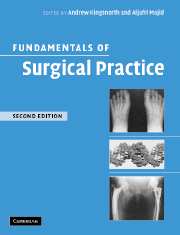Book contents
- Frontmatter
- Contents
- Preface
- Contributors
- 1 Preoperative management
- 2 Principles of anaesthesia
- 3 Postoperative management
- 4 Nutritional support
- 5 Surgical sepsis: prevention and therapy
- 6 Surgical techniques and technology
- 7 Trauma: general principles of management
- 8 Intensive care
- 9 Principles of cancer management
- 10 Ethics, legal aspects and assessment of effectiveness
- 11 Haemopoietic and lymphoreticular systems: anatomy, physiology and pathology
- 12 Upper gastrointestinal surgery
- 13 Lower gastrointestinal surgery
- 14 Hernia management
- 15 Vascular surgery
- 16 Endocrine surgery
- 17 The breast
- 18 Thoracic surgery
- 19 Genitourinary system
- 20 Head and neck
- 21 The central nervous system
- 22 Musculoskeletal system
- 23 Paediatric surgery
- Index
17 - The breast
Published online by Cambridge University Press: 15 December 2009
- Frontmatter
- Contents
- Preface
- Contributors
- 1 Preoperative management
- 2 Principles of anaesthesia
- 3 Postoperative management
- 4 Nutritional support
- 5 Surgical sepsis: prevention and therapy
- 6 Surgical techniques and technology
- 7 Trauma: general principles of management
- 8 Intensive care
- 9 Principles of cancer management
- 10 Ethics, legal aspects and assessment of effectiveness
- 11 Haemopoietic and lymphoreticular systems: anatomy, physiology and pathology
- 12 Upper gastrointestinal surgery
- 13 Lower gastrointestinal surgery
- 14 Hernia management
- 15 Vascular surgery
- 16 Endocrine surgery
- 17 The breast
- 18 Thoracic surgery
- 19 Genitourinary system
- 20 Head and neck
- 21 The central nervous system
- 22 Musculoskeletal system
- 23 Paediatric surgery
- Index
Summary
BASIC BIOLOGY
Anatomy of the breast
Embryology
The breast is a modified sweat gland which originates from the ectodermal layer of the embryo between the fifth and sixth week of gestation. It arises from the ‘milk lines’, which are two ridges of ectodermal thickening, running from the axilla to the groin. Although most of the ‘milk line’ eventually disappears, a prominent ridge remains in the pectoral area to form the breast. The ectoderm in this area subsequently grows into the underlying mesoderm as a series (15–20) of buds. These ectodermal buds, which are initially solid, eventually form the lactiferous ducts and their associated alveoli. The adjacent mesenchyme develops into the surrounding adipose and connective tissues. During the final 2 months of gestation, the ducts become canalised and a ‘mammary pit’ is formed in the ectoderm. The lactiferous ducts subsequently communicate with the mammary pit.
Gross anatomy
Morphological features
The breast is situated within the subcutaneous tissue of the anterolateral chest wall. It extends from the second to the sixth rib and from the edge of the sternum to the mid-axillary line, overlying the pectoralis major, serratus anterior, upper part of the rectus sheath and external oblique muscles. The breast extends in a supero-lateral direction along the border of the pectoralis major muscle, through the foramen of Langer in the deep fascia of the axilla, to lie close to the pectoral group of axillary lymph nodes. This is termed the axillary tail of Spence.
- Type
- Chapter
- Information
- Fundamentals of Surgical Practice , pp. 322 - 350Publisher: Cambridge University PressPrint publication year: 2006

